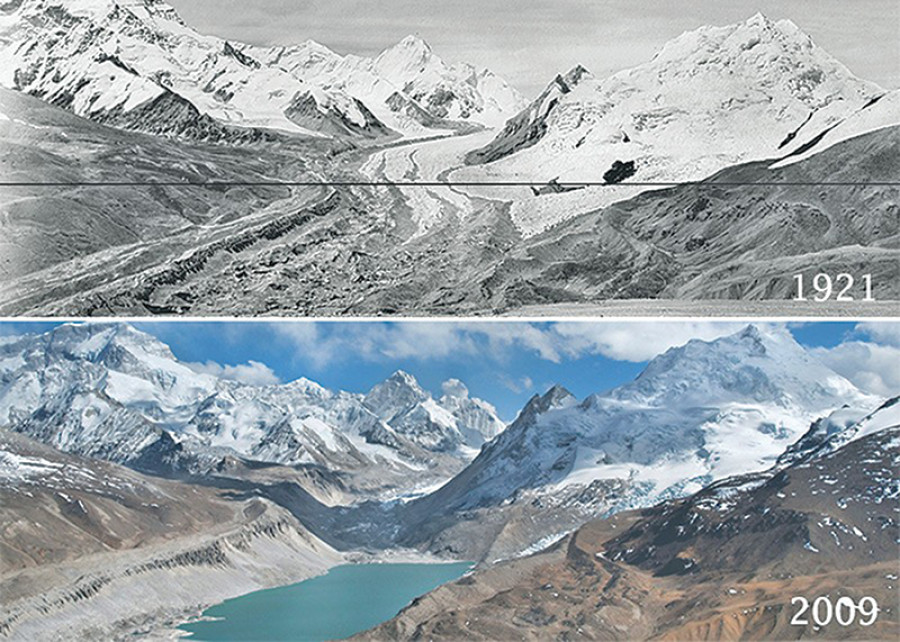Opinion
When ice turns to water
Rising temperature due to climate change is taking its toll on mountains
Kantilata Thapa
The world’s mountains are home to about 800 million people. It provides crucial ecosystem services for the entire globe, including freshwater for half of humankind. The mountains also encompass a great degree of biodiversity, including many endemic species–species that occur nowhere else.
The Himalayas and the Tibetan Plateau are the major headwaters for almost all of the rivers that flow through Asia. The runoff from the Tibetan Plateau supplies water to an estimated 1.5 billion people, and changes in runoff could have profound social, environmental, economic and security implications due to climate change.
The mountains of Nepal are geographically fragile and are extremely susceptible to the profound effects of climate change. The challenging land topography and poor socio-economic conditions make the country highly vulnerable to the effects of climate change.
Over the years, Nepal has experienced a rise in average temperature of about 0.06 °C from 1975 to 2005. Furthermore, the mean annual temperature of Nepal has been projected to increase between 1.3-3.8°C by the 2060s and between1.8-5.8°C by the 2090s. If such a pattern continues, the iconic Mount Everest may be unclimbable in the near future.
According to the International Centre for Integrated Mountain Development (ICIMOD), mountains cover around 25 percent of the earth’s land surface and host about 13 percent of the world’s population. They are providers of essential ecosystem goods and services to billions of people living in the mountains and surrounding areas. The mountain regions are rich in timber and medicinal and aromatic herbs, and they could generate substantial incomes for the local people. These resources, however, have remained underused or untapped for centuries due to lack of development infrastructure and sheer negligence of the government.
Apa Sherpa, a living legend, and an acclaimed mountaineer have scaled Everest a record-breaking 20 times. Sherpa was once a farmer but decided to change profession and became a mountaineer after a GLOF (Glacier lake outburst floods) swept away his home and farm in 1985. According to a 2013 study on GLOFs, “In the Himalayas, catastrophic risks of GLOFs have increased in recent years because most Himalayan glaciers have experienced remarkable down wasting under a warming climate”. Evidence suggests that the extreme warming of the planet and erratic rainfall can be blamed for this. Due to the difficult topography, mountain regions are isolated and hard to access and these mountain communities are extremely vulnerable as it is very difficult for them to receive immediate relief in times of disaster.
A new report of National Academy of Science and Technology (NAST) reveals that there have been changes in tree-line vegetation in the mountainous part of the Manaslu region with the timberline moving upward in recent decades. As the snow-capped mountains continue to melt, people residing around the highlands are facing adverse the impacts on their livelihood. According to a recent study conducted by the Chinese Academy of Science and the Human University of Science and Technology, the glacial lakes on Mt Everest are melting as temperatures have been rising in the past 50 years.
Of the roughly 198,000 glaciers on the planet, more than a quarter are found in the Himalayas. Many Himalayan glaciers are receding—and a new study of 32 glaciers around Mount Everest has found that those terminating in lakes have lost more ice mass than landlocked glaciers. This is a worrying trend because many glacial lakes form behind unstable debris dams that are poised to collapse and send disastrous floods hurtling down valleys.
Despite the dangers of climate change and its effects on the mountains of Nepal, the issue of mountain environments hasn’t been adequately addressed in international policy deliberations. Active collaboration of the international community along with an immediate response to limit the increasing trend of temperature to below 1.5 °C can ensure a successful future of the mountain ecosystem.
Developing countries like Nepal should appeal to the international community to collaborate and establish a common platform to discuss mountain concerns. The need for different strategies of land use and management in different mountain regions, empowerment of mountain communities by encouraging leadership, use of local knowledge and promoting platforms that enable learning and collective action can ensure more sustainable use of common resources and increase resilience to climate change.
The decline of snow and ice in the Everest region was a direct result of human-generated greenhouse gases altering global climate. The authorities concerned should take immediate measures to conserve the world’s highest mountain and other peaks for the living nature and people in the mountain regions of Nepal.
Thapa is the Regional Exchange Coordinator at the Institute of Agriculture and Animal Science.




 10.12°C Kathmandu
10.12°C Kathmandu










